Modern Interior Glass Doors Design Ideas and Tips
Table of Contents
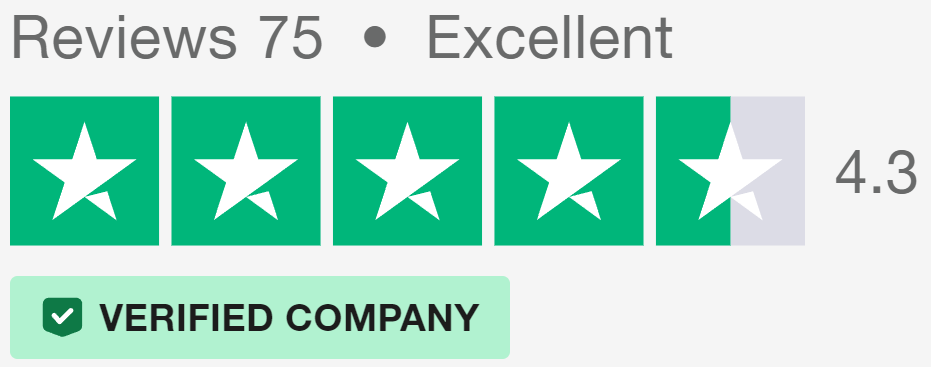
Types of Modern Interior Glass Doors for Contemporary Homes
Modern interior glass doors have sparked a quiet revolution in home design. From slim profile sliding doors to dramatic floor-to-ceiling panels, glass doors are rewriting the rules of internal architecture.
Sliding Glass Door Systems
Minimalist glass doors glide effortlessly along concealed tracks, their smooth operation matched by clean lines and subtle hardware. Premium sliding systems can span entire walls, with frames as slim as their engineering allows. The glass panels themselves move on precision-engineered rollers, virtually silent in operation.
In compact urban homes, sliding mechanisms prove particularly valuable. Rather than swinging open into precious floor space, the panels slide parallel to walls—perfect for narrow hallways or small rooms where every centimetre counts. Modern interior glass doors in sliding configurations often incorporate soft-close technology, preventing slams and protecting the glass.
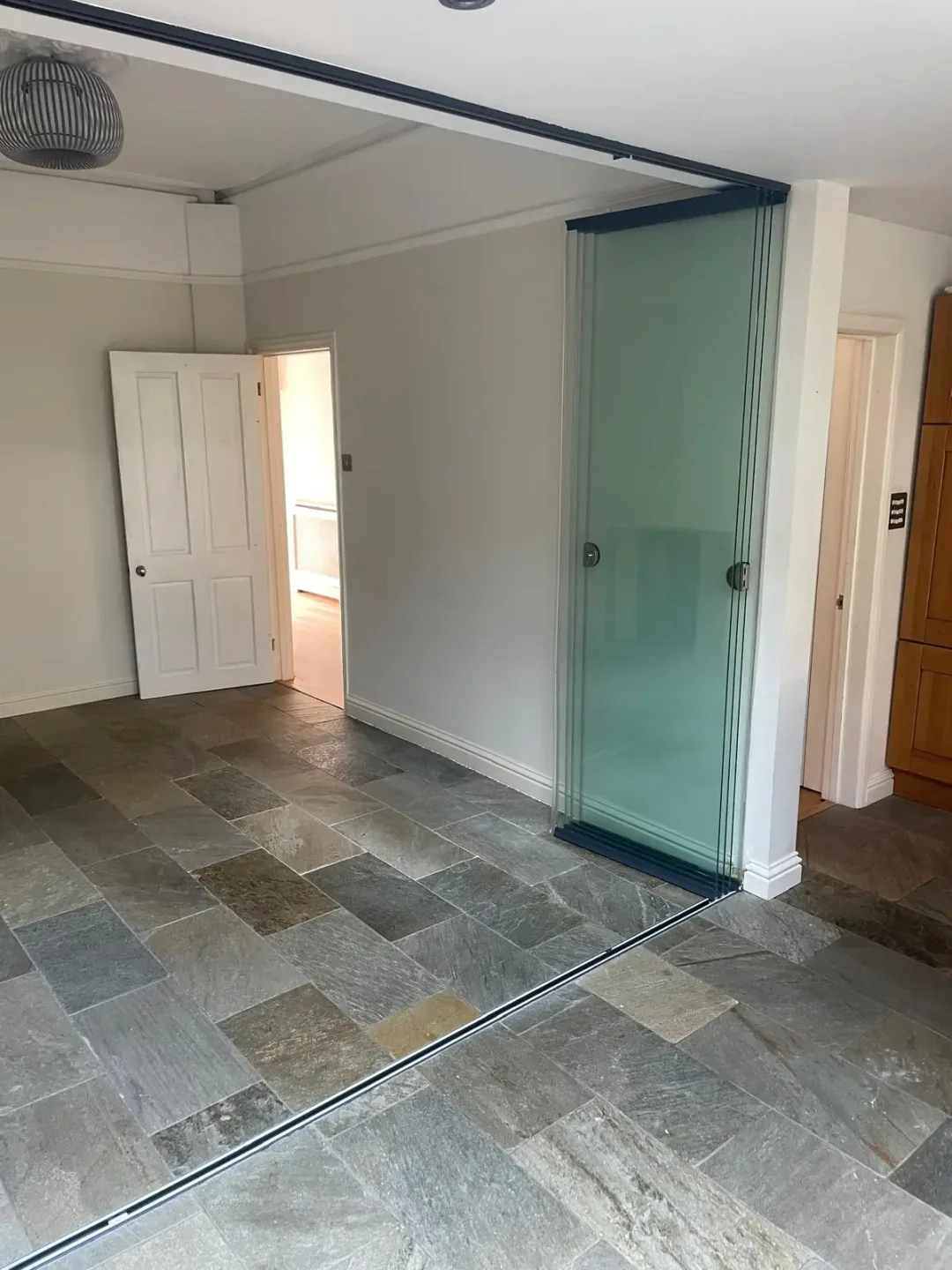
Bifolding Glass Door Options
Architectural glass reaches new heights with contemporary bifolding systems. Each panel folds against its neighbour, creating a striking zigzag when open. Unlike traditional concertina doors, modern designs emphasise clean sightlines and minimal frame profiles.
Frameless folding glass doors represent the pinnacle of minimal design—pure glass with barely visible hinges and tracks. The panels stack neatly to one or both sides, their crystalline edges catching light as they move. Top-hung systems eliminate the need for a bottom track, resulting in a continuous floor finish.
Slide and Fold Mechanisms
Modern interior design often demands flexibility, and slide-and-fold systems deliver exactly that. The panels first slide, then pivot and stack—offering multiple configuration options from fully open to partially closed. Interior glass partitions created with these systems can divide spaces during work hours, then fold away for evening entertainment.
The engineering behind these mechanisms allows for larger glass panels than standard bifolds. German-engineered systems lead the field, with robust bearings supporting weights up to 100kg per panel. Despite their size, the panels move with remarkable ease.
Advanced Track Systems
Top-mounted tracks support the entire system while remaining nearly invisible from below. The minimalist aesthetic extends to the hardware—brushed stainless steel handles sit flush against the glass, while discrete locks secure the panels without disrupting their clean lines. Some manufacturers now offer trackless systems, though these typically suit smaller installations where stability requirements are lower.
Glass Door Configurations That Make a Statement
A well-designed configuration of modern interior glass doors can turn an ordinary wall into an architectural masterpiece. Striking arrangements of glass panels bring light and movement into spaces that once felt static and dim.
Full-Height vs Partial Glass Panels
Modern interior glass doors that stretch from floor to ceiling create an imposing presence in any room. These full-height installations make ceilings appear higher while drawing the eye upward through their vertical lines. Partial-height panels, by contrast, often work better in period properties where original features need preservation.
Glass panelled doors measuring two metres or less maintain proportion in rooms with standard ceiling heights. The solid sections above and below the glass provide natural framing, while modern finishes like matt black or brushed steel add subtle detail. Some homeowners opt for frosted sections at eye level, with clear glass above and below—an innovative approach to privacy that preserves natural light.
Contemporary doors with varying panel heights can create rhythm across a wall. Modern home interiors often feature asymmetric arrangements, where different-sized glass sections play against each other. The visual interest comes from these carefully planned contrasts, rather than from ornate details or busy patterns.
Pivot Hinges
Modern interior glass doors mounted on pivot hinges defy expectations about how doors should move. Unlike traditional hinges fixed to one edge, pivot systems support the door’s weight through a single point at top and bottom. The door rotates around this axis, creating a captivating motion as it opens.
Offset pivot points add another layer of intrigue. When the pivot sits away from the door’s centre, the panel’s movement describes an elegant arc through space. These modern glass interior doors require careful planning—their swing path needs more clearance than conventional hinged doors—but the visual payoff justifies the extra thought.
Multi-Panel Systems for Flexible Living
The latest variety of styles in panel configuration allows unprecedented control over space division. Modern interior glass doors can divide rooms without blocking sight lines or light. Three-panel systems fold into compact stacks, while four-panel arrangements might split in the middle, stacking to either side.
Advanced Configuration Options
Modern glass internal doors now offer configuration possibilities that were impossible just years ago. Corner installations remove structural posts entirely, opening up right-angled spaces completely. Curved tracks guide panels in sweeping arcs, perfect for circular rooms or curved walls. Some systems even allow panels to park perpendicular to the track, tucking away completely when open.
Low-iron glass eliminates the green tinge found in standard glass, resulting in crystal-clear panels that seem to disappear. Laminated acoustic glass reduces sound transmission while maintaining visual clarity, making these systems practical for home offices and music rooms.
Asymmetric Layouts
Breaking free from conventional symmetry, modern interior glass doors can follow more daring arrangements. Panels of different widths create visual interest while serving practical purposes—a wider panel for main access, narrower ones for occasional use. These asymmetric configurations turn the doors themselves into architectural features rather than mere room dividers.
In open-plan spaces, varying panel sizes help define different functional zones. A quartet of modern glass interior doors might feature a large central panel flanked by smaller ones, creating a hierarchy of openings that subtly guides movement through the space. Architects often use these arrangements to frame specific views or direct attention to particular areas of a room.
Modern Interior Glass Door Design Elements
Modern interior glass doors rely on the interplay of their core components: glass, frames, and hardware. Each element contributes to the door’s look and performance, creating a harmonious whole that serves its practical purpose while adding visual interest.
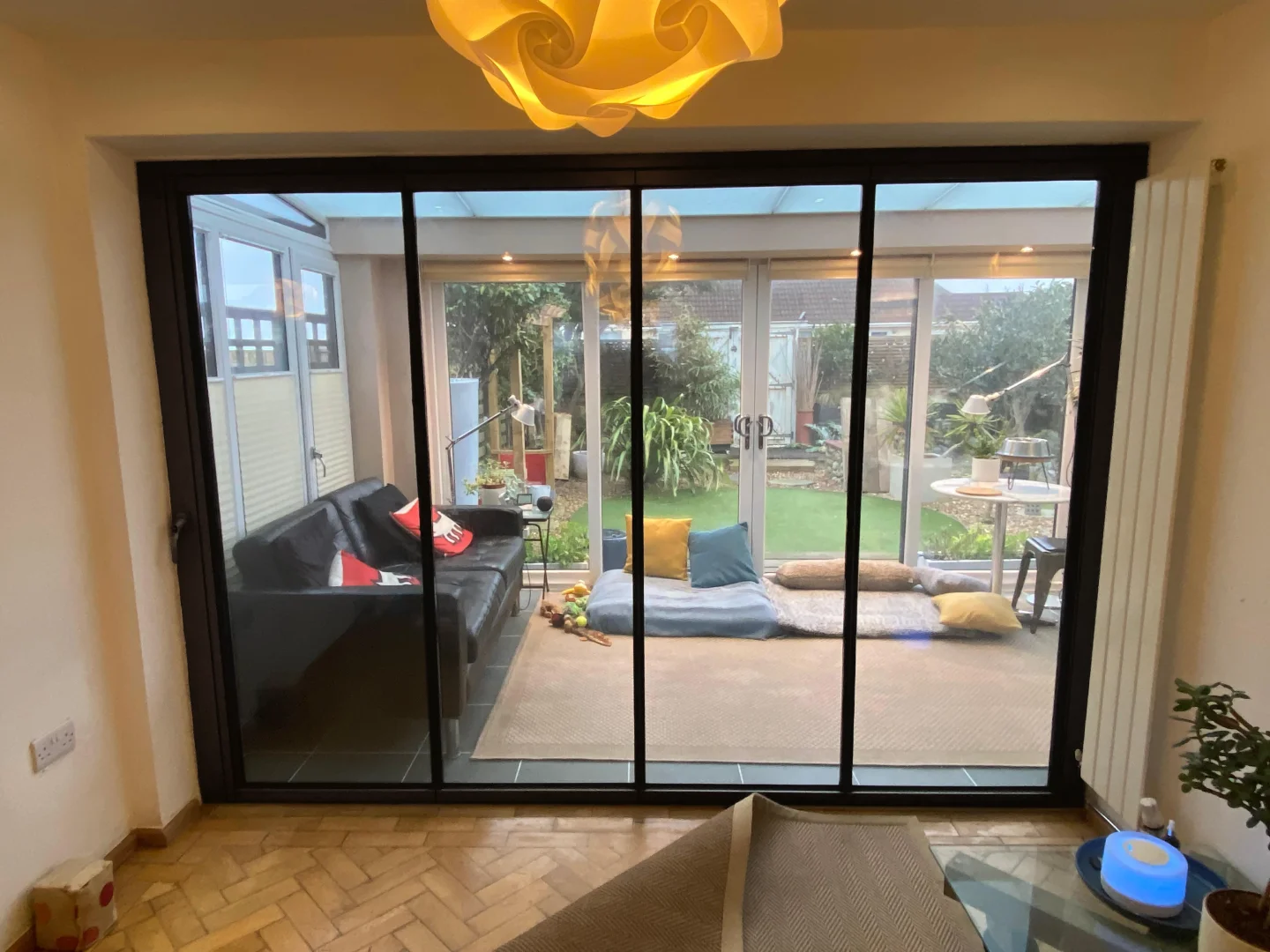
Frame Designs and Their Visual Impact
Internal aluminium doors showcase engineering precision through minimal frames. The strength of modern aluminium alloys allows for incredibly slim profiles, some measuring just millimetres in width. These slender frames direct attention to the glass itself while providing the necessary structural support.
Modern interior glass doors often eschew frames altogether. Frameless systems use structural glass with polished edges, secured by discrete clips and patches. The glass appears to float in space, its edges catching and refracting light. This pure glass aesthetic works particularly well in contemporary architecture where clean lines dominate.
Modern doors push boundaries with innovative frame materials. Carbon fibre composites offer extraordinary strength-to-weight ratios, enabling even slimmer profiles than aluminium. Powder-coated steel frames provide industrial character, their matt finishes contrasting beautifully with the glass’s reflective surface.
Glass Types and Finishes
Contemporary doors feature an array of glass options beyond simple clear panes. Frosted glass creates privacy without sacrificing light transmission—ideal for bathrooms or home offices. The frosting process can create patterns or gradients, adding subtle visual interest to modern interior doors with glass.
Low-iron glass eliminates the greenish tint found in standard glass, resulting in exceptional clarity. This premium option proves particularly valuable in modern interior glass doors where transparency is paramount. The crystal-clear appearance makes the glass nearly invisible when clean, though fingerprints show more readily than on standard glass.
Specialist Glass Options
Modern glass internal doors can incorporate advanced glass types for specific applications. Acoustic laminated glass reduces sound transmission while maintaining clarity. Fire-rated glass meets building regulations without compromising the minimal aesthetic. Some manufacturers offer glass with integrated LED elements, creating dramatic lighting effects after dark.
Hardware and Metal Accents
Hardware design for modern interior glass doors focuses on minimalism and precision. Handles machined from solid stainless steel or brass provide tactile quality and visual restraint. Hidden hinges disappear into door edges or floor channels, maintaining clean lines throughout the installation.
Track systems for sliding configurations demonstrate similar attention to detail. Precision-engineered rollers glide silently on aerospace-grade bearings. Top-hung systems eliminate visible floor tracks, while bottom-rolled options distribute weight more evenly for larger panels.
Lock mechanisms balance security with aesthetics. Magnetic locks eliminate the need for visible strikers, while edge-mounted deadbolts integrate discreetly into the glass. Some systems use electronic locks with fingerprint recognition, eliminating visible hardware entirely.
Modern interior glass doors often feature custom metalwork. Specialist fabricators can create bespoke handles and hinges that complement specific architectural details. These unique elements turn standard components into signature features, adding personality without compromising the clean aesthetic.
Modern Interior Glass Doors in Open-Plan Living
Glass doors can completely change how we use our living spaces. Modern interior glass doors give homeowners the power to split or join rooms as needed, while keeping spaces bright and open-feeling.
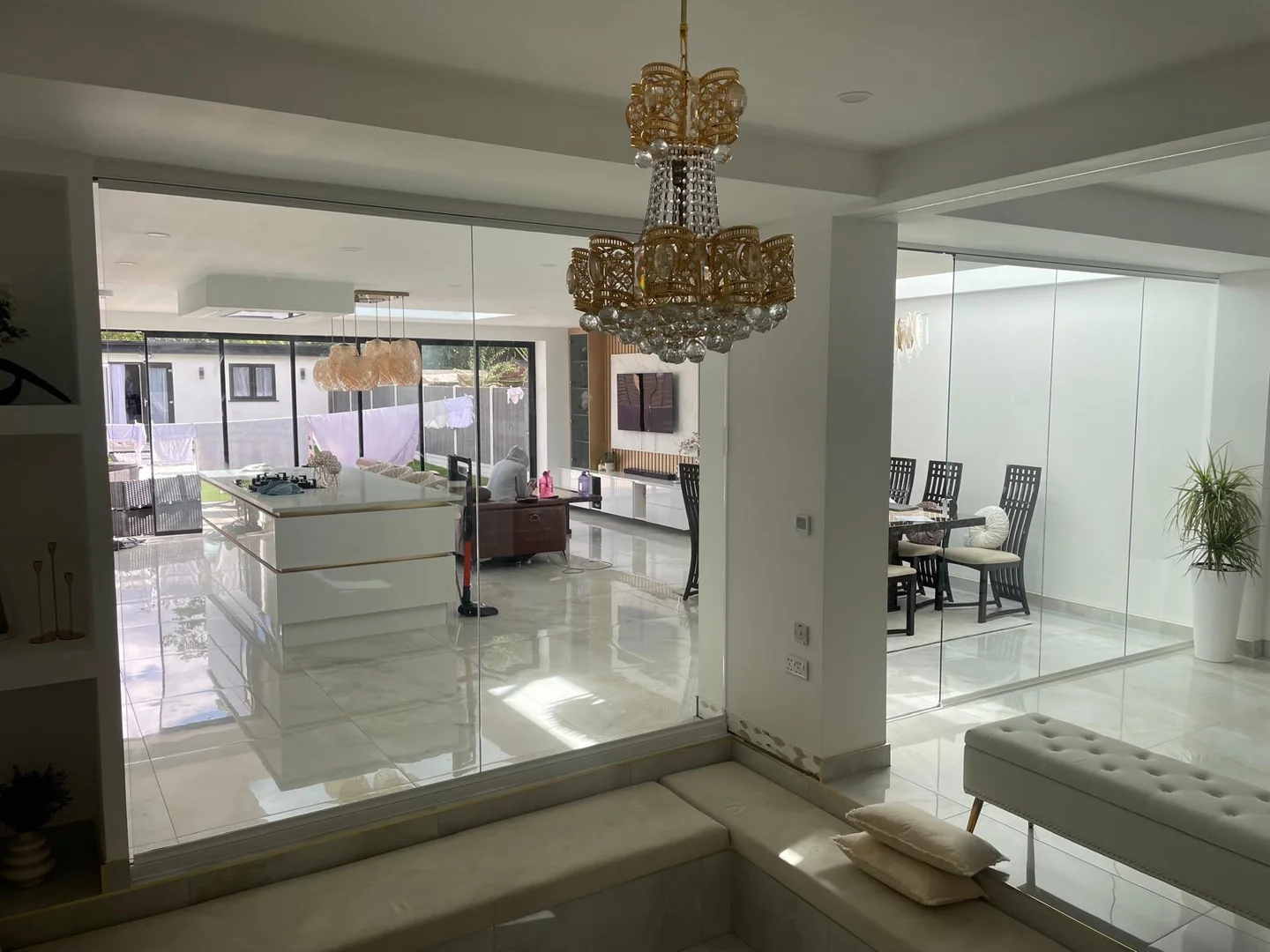
Creating Fluid Room Divisions
Period homes often need careful updates to match modern living patterns. Modern internal doors with glass help divide larger spaces without blocking natural light. A kitchen-diner might use sliding glass panels to close off cooking smells when needed, while keeping the visual connection between spaces.
Modern interior glass doors work especially well in home offices. A glass partition can mark the boundary between work and home life, while still letting you keep an eye on children or pets. The sound-dampening properties of double-glazed panels help create a quieter workspace without making you feel cut off.
Folding glass walls take space division to new levels. These systems can open up entirely, pushing back against walls or stacking in dedicated pockets. When closed, they act as solid walls. When open, they disappear almost completely, letting you use your space in different ways throughout the day.
Light Flow and Space Management
Modern interior glass doors change how light moves through buildings. A dark hallway can borrow brightness from adjacent rooms through glass panels. Even on cloudy days, the light that does enter travels further into the building, reducing the need for artificial lighting.
Glass doesn’t have to mean totally clear views. Modern glass interior doors come in various opacity levels. Rippled or reeded glass creates interesting light patterns while offering privacy. Sandblasted panels let light through while obscuring direct views – perfect for bathroom areas or changing rooms.
The position of glass doors shapes how people move through spaces. Placing doors at angles rather than straight on can guide foot traffic naturally. Corner installations of modern interior glass doors can open up two walls at once, creating a striking architectural feature that completely changes how a room feels.
Strategic Panel Placement
Getting the most from glass doors means thinking carefully about their location. South-facing installations might need solar control glass to prevent overheating. North-facing positions might benefit from low-iron glass to maximise available light. Some homeowners install UV-protective glass to stop sunlight from fading artwork or furniture.
Adaptable Living Spaces
Modern internal doors with glass make rooms more useful. A dining room can become a temporary classroom. Living rooms can expand for parties. These changes happen quickly and easily, without the permanence of solid walls or the fuss of curtains and screens.
The latest systems offer impressive flexibility. Some designs let you slide panels into wall pockets, hiding them completely when not needed. Others use curved tracks to create smooth sweeping openings. Motorised systems can even move panels automatically at the touch of a button.
Glass doors work particularly well in properties with unusual layouts. Mezzanine levels benefit from glass barriers that keep spaces safe while maintaining visual connections. Basement conversions feel brighter and more connected to the rest of the house when modern interior glass doors replace solid walls.
Smart glass technology adds another layer of adaptability. These advanced systems switch from clear to opaque electronically. While expensive, they offer ultimate control over privacy and light levels without additional curtains or blinds. The glass can even display images or information when in its opaque state.
Children’s play areas show how glass doors can make spaces safer and more practical. Parents can keep watch while containing noise and mess. The doors act as physical barriers while maintaining clear sightlines – essential for supervision without hovering.
Styling Spaces Around Modern Interior Glass Doors
Light, space, and visual flow merge when modern interior glass doors form part of your interior design strategy. Through careful styling and thoughtful placement, these architectural elements become integral to a room’s character.
Material and Texture Combinations
Pairing raw concrete walls with modern internal glass doors creates striking industrial appeal, while exposed brick adds warmth and textural interest. Natural stone flooring grounds glass installations with its solid presence, the reflective surfaces playing against rough-hewn textures. Wooden elements, from rich oak beams to pale ash panelling, bring organic warmth to balance the precision of glass.
Modern interior glass doors take on new dimensions when surrounded by interesting surface treatments. Polished plaster walls catch light differently throughout the day, their subtle sheen complementing the glass’s reflective qualities. Tactile wall coverings – from grasscloth to leather panels – provide contrast to smooth glass surfaces.
Metallic accents near modern interior glass doors need careful planning. Copper and brass details patina over time, creating ever-changing points of interest. Stainless steel maintains its crisp appearance but shows fingerprints readily. Powder-coated aluminium offers durability with minimal maintenance.
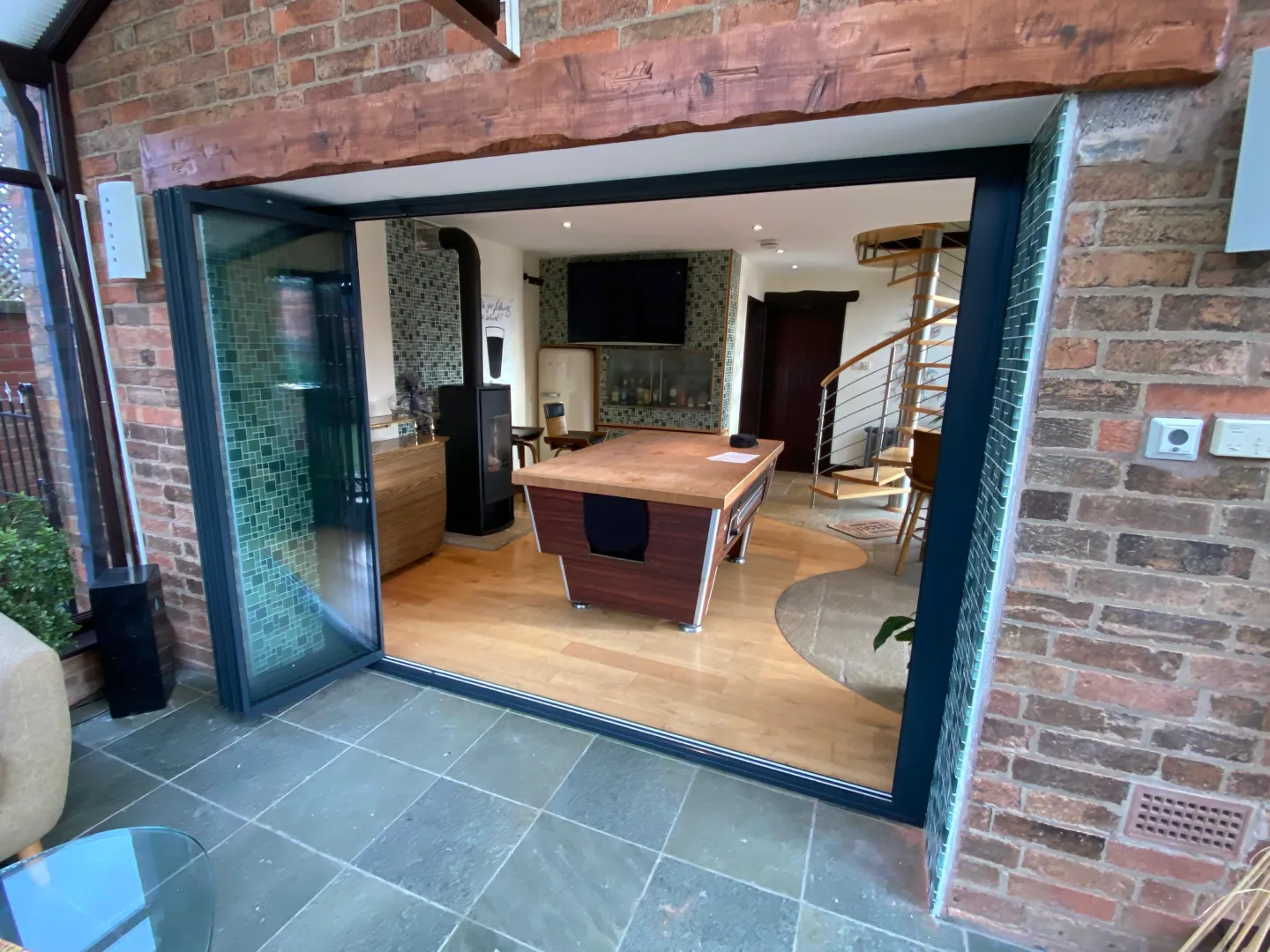
Furniture Arrangement and Flow
Glass room dividers demand furniture layouts that work whether the doors are open or closed. Low-profile seating allows uninterrupted views through glass panels, while modular pieces adapt as spaces change. Positioning key furniture pieces perpendicular to glass doors maintains clear walking paths while defining distinct zones within larger spaces.
Modern glass interior doors influence traffic patterns throughout a space. Strategic furniture placement can direct movement naturally, preventing awkward bottlenecks near door openings. Rugs help define separate areas without physical barriers, their edges echoing the lines of nearby glass installations.
Careful thought goes into furniture scale when working with modern interior glass doors. Oversized pieces might overpower delicate door frames, while very small items can look lost in expansive glass-walled spaces. Multi-height arrangements create visual interest without blocking light flow.
Lighting Design Integration
Morning sun streaming through modern internal doors with glass creates ever-changing shadow patterns across walls and floors. Artificial lighting schemes can mimic this effect after dark, with carefully positioned spotlights highlighting glass edges and frame details. Strip lighting concealed in floor channels or ceiling recesses washes glass surfaces with soft illumination.
Track lighting offers flexibility when styling spaces around glass doors. Adjustable spots can highlight artwork or architectural features as room layouts change. Wall-mounted uplighters cast gentle pools of light upward, reducing glare on glass surfaces while adding atmosphere.
Specialist Lighting Effects
LED strips integrated into door frames or tracks add subtle definition after dark. Colour-changing systems allow different moods for different occasions. Some modern interior glass doors now incorporate photochromic elements that respond to changing light levels, automatically adjusting their opacity throughout the day.
Natural Elements and Softening Techniques
Plants thrive near glass doors, benefiting from abundant natural light. Tall specimens create privacy without sacrificing brightness, their organic forms softening hard architectural lines. Trailing varieties can frame doorways naturally, while compact plants in striking containers add visual anchors to glass-heavy spaces.
Living walls installed near modern interior glass doors create stunning focal points. These vertical gardens introduce nature at eye level, their changing seasons bringing dynamic interest to minimal interiors. Maintenance access requires planning, but the visual impact justifies the extra thought.
Water features provide ambient sound and movement in spaces divided by glass. Small fountains mask noise from adjacent areas without blocking views. The sound of moving water adds a calming element to home offices or meditation spaces separated by glass panels.
Textiles play a vital part in spaces with extensive glazing. Sheer curtains filter harsh sunlight while maintaining privacy. Heavier fabrics can block light completely when needed, their folds adding acoustic benefits and visual warmth to glass-walled spaces. Wall hangings and tapestries bring colour and texture while helping control sound reflection from hard surfaces.
We’d Love to Help You
Vision Glass Doors is a designer, manufacturer, and installer of premium door systems. We are a family run business with over 20 years’ experience and 5,000 installations across the UK.
Our leading range of door systems include Ultra Slim – Slide and Turn Doors, Slimline Sliding Patio Doors and Frameless Glass Doors. Suitable for various internal and external applications, they are applicable to residential and commercial projects.
Click Quick Quote Online for a free quotation within 24 hours. Alternatively, call or email us on 01582 492730 or at info@visionglassdoors.co.uk.

